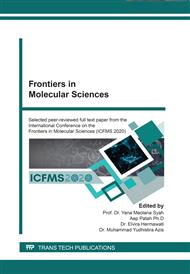[1]
A. Fakhru'L-Razi, I.Y.M. Qudsieh, W.M.Z.W. Yunus, M.B. Ahmad, M.Z.A. Rahman, Graft copolymerization of methyl methacrylate onto sago starch using ceric ammonium nitrate and potassium persulfate as redox initiator systems, Journal of Applied Polymer Science 82 (2001) 1375-1381.
DOI: 10.1002/app.1974
Google Scholar
[2]
L. Rahman, S. Silong, W.M. Zin, M.Z.A. Rahman, M. Ahmad, J. Haron, Graft copolymerization of methyl acrylate onto sago starch using ceric ammonium nitrate as an initiator, Journal of Applied Polymer Science 76 (2000) 516-523.
DOI: 10.1002/(sici)1097-4628(20000425)76:4<516::aid-app9>3.0.co;2-7
Google Scholar
[3]
M. Sova, Antioxidant and antimicrobial activities of cinnamic acid derivatives, Mini-Reviews in Medicinal Chemistry 12 (2012) 749-767.
DOI: 10.2174/138955712801264792
Google Scholar
[4]
T.C. Lima, A.R. Ferreira, D.F. Silva, E.O. Lima, D.P. de Sousa, Antifungal activity of cinnamic acid and benzoic acid esters against candida albicans strains, Natural Product Research 32 (2018) 572-575.
DOI: 10.1080/14786419.2017.1317776
Google Scholar
[5]
B. Korošec, M. Sova, S. Turk, N. Kraševec, M. Novak, L. Lah, J. Stojan, B. Podobnik, S. Berne, N. Zupanec, M. Bunc, S. Gobec, R. Komel, Antifungal activity of cinnamic acid derivatives involves inhibition of benzoate 4-hydroxylase (cyp53), Journal of Applied Microbiology 116 (2013) 955-966.
DOI: 10.1111/jam.12417
Google Scholar
[6]
J. Berthold, R.J.O. Olsson, L. Salmén, Water sorption to hydroxyl and carboxylic acid groups in carboxymethylcellulose (cmc) studied with nir-spectroscopy, Cellulose 5 (1998) 281-298.
Google Scholar
[7]
Y. Murata, K. Nagaki, K. Kofuji, F. Sanae, H. Kontani, S. Kawashima, Adsorption of bile acid by chitosan salts prepared with cinnamic acid and analogue compounds, Journal of Biomaterials Science, Polymer Edition 17 (2006) 781-789.
DOI: 10.1163/156856206777656517
Google Scholar
[8]
P. Pal, J.P. Pandey, R. Rahul, G. Sen, A novel biodegradable cinnamic acid grafted carboxymethyl cellulose based flocculant for water treatment, Materials Science Forum 875 (2016) 156-166.
DOI: 10.4028/www.scientific.net/msf.875.156
Google Scholar
[9]
P. Raffa, A.A. Broekhuis, F. Picchioni, Polymeric surfactants for enhanced oil recovery: A review, Journal of Petroleum Science and Engineering 145 (2016) 723-733.
DOI: 10.1016/j.petrol.2016.07.007
Google Scholar
[10]
I.R.M. Benesi, M.T. Labuschagne, A.G.O. Dixon, N.M. Mahungu, Stability of native starch quality parameters, starch extraction and root dry matter of cassava genotypes in different environments, Journal of the Science of Food and Agriculture 84 (2004) 1381-1388.
DOI: 10.1002/jsfa.1734
Google Scholar
[11]
D. Fajardo, S.S. Jayanty, S.H. Jansky, Rapid high throughput amylose determination in freeze dried potato tuber samples, Journal of visualized experiments : JoVE (2013) e50407.
DOI: 10.3791/50407-v
Google Scholar
[12]
Q. Chen, H. Yu, L. Wang, Z. ul Abdin, Y. Chen, J. Wang, W. Zhou, X. Yang, R.U. Khan, H. Zhang, X. Chen, Recent progress in chemical modification of starch and its applications, RSC Advances 5 (2015) 67459-67474.
DOI: 10.1039/c5ra10849g
Google Scholar
[13]
I. Goñi, M. Gurruchaga, B. Vazquez, M. Valero, G.M. Guzman, Synthesis of graft copolymers of acrylic monomers on amylose: Effect of reaction time, European Polymer Journal 28 (1992) 975-979.
DOI: 10.1016/0014-3057(92)90327-x
Google Scholar
[14]
D.R. Rohindra, R.A. Lata, R.K. Coll, A simple experiment to determine the activation energy of the viscous flow of polymer solutions using a glass capillary viscometer, European Journal of Physics 33 (2012) 1457.
DOI: 10.1088/0143-0807/33/5/1457
Google Scholar


